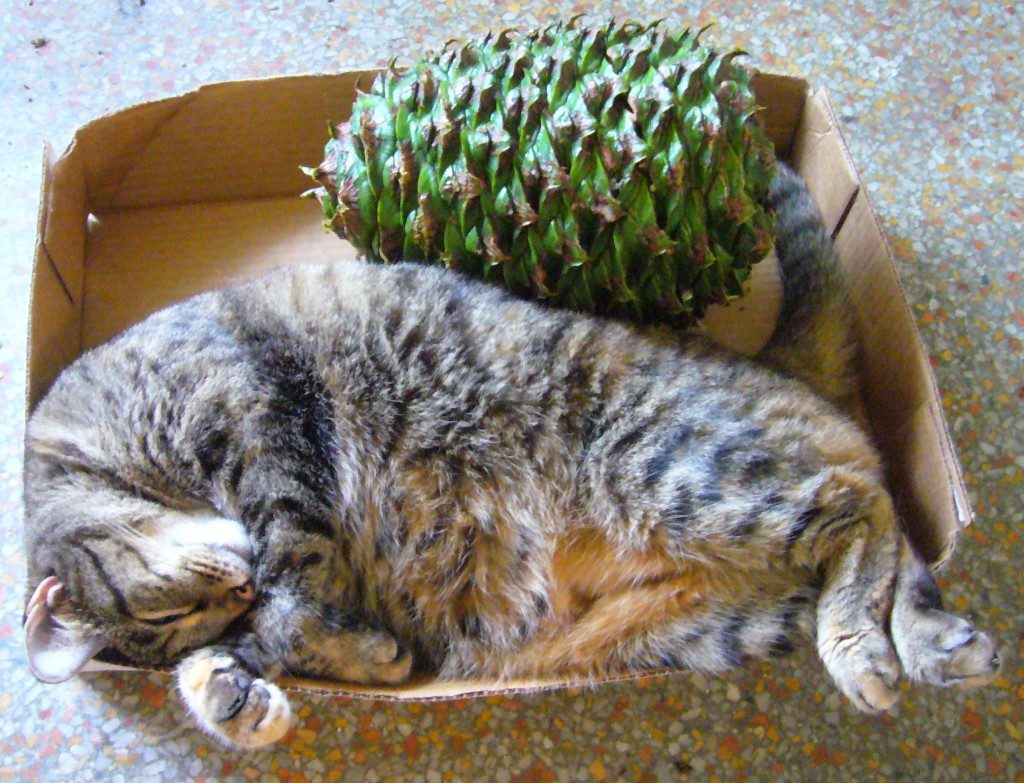
Cous Cous cuddling up to a Bunya Bunya cone. You should be scouting the ground for these now where ever Bunya Bunya grow. You can read more about them here. Photo by Green Deane
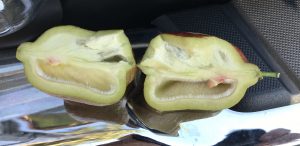
The fruit of the Rose Apple found by Rose-Ann. Photo by Green Deane
There is probably some Syzygium in your kitchen. Syzygium is a genus with several useful trees. Syzygium cumini produces the Java Plum also called Jambul. Syzygium jambos is the Rose Apple and Syzygium samaragense is the Java Apple (though common names can vary.) The Syzygium in your kitchen is S. aromaticum. You know the dried flower buds as “cloves.” I know where there is a S. cumini in Orlando (and dozens in West Palm Beach.) Another member of the genus was found recently locally though whether its a S. jambos or S. samaragense requires more investigation. The fruit is cut open on right. If it has a bit of a rose aroma or taste then it’s the S. jambos. If not then perhaps the S. samaragense. I look forward to learning more about it. Thanks to Rose-Ann for bringing it to my attention.
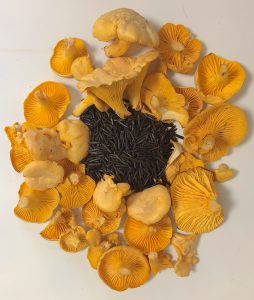
Wild Chanterelles and wild rice waiting to be cooked. Photo by Green Deane
I was asked this morning by one of the retired fellows I bike with if the rain was helping my plants. That’s kind of on par with “is sunshine helping your plants?” What he meant but did not say was did the recent rains make a difference. I’m not sure it moved the chlorophylic needle much on green plants but it did stimulate a huge flush of edible Chanterelles. Several friends and I collected them for several days and did not put a dent in the abundance. (By the way harvesting wild mushrooms is what the mushroom wants just as an an apple tree wants its apples moved.) So I’ve been having chanterelles several times this week. All mushroom should be stored in paper bags (not plastic) and washed only right before cooking. (I’m certified to sell wild mushrooms in several states.) Interestingly those who study such things now say no mushrooms — wild or cultivated — should be eaten raw. Over a life time, they say, eating raw mushrooms can increase the risk for mitochondria-based cancer. Cook your mushrooms.
One of the disappointments this time of year is that the Seagrapes are not quite ripe, as we saw in Ft. Desoto Sunday. However, the Tuna are running… well… actually ripening: Cactus fruit are called Tuna. We saw plenty of those. There are two or three general types of cactus locally, Opuntia and Nopales and a third with edible fruit, the Cereus, which is more an ornamental Dragon Fruit. How do you pick a Tuna (or cactus pad?) In a word carefully.
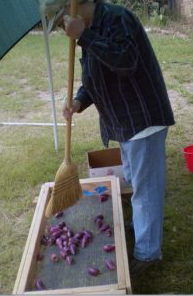
Sweeping glochids off is another option.
Most foragers know cactus have edible parts but what does one look for, generally? First make sure it’s a pad, segmented often oval or tear-drop shaped. You do not want anything that looks serpentine. Also no white sap. White sap in plants that resemble cactus can be very deadly even after being dry many years. In one case smoke from burning desiccated Euphorbia branches killed some stranded people. They were trying to stay warm around the fire on a cold desert night. So, pads, no white sap. While which cactus you collect (Opuntia, Nopales, or Cereus) might be the luck of the draw, the less spines the better, and the less glochids the much better. Glochids are tiny tuffs of sharp hair that hurt, are hard to dig out, and last for days. Ma Natures knows the pads and Tuna are good food so she protects them mightily. Big spines can be cut, burned or scraped off, glochids burned or washed off. Just scraping is not so successful with glochids. Wear stiff gloves without seams. Those little glochids will pass right through seams and get ya. Hint: Young pads, the ones we want anyway, often have not developed glochids. The Tuna have them so pick with tongs and sweep, wash or burn the painful spines off. Let us presume you have a spineless, glochidless young pad. What do you do with it? You can eat it raw, skin and all, or roast it or boil it. I know one restuarant that steams them (preserving color) then lightly grills them puting the pads whole on a Mexicanesque hamburgers. With older (de-spined) pads you can still eat them raw or cook. Usually the tougher spine “eyes” are removed just like you would with a potato. And the pad can be peeled as well. Pads at a certain point become woody and too tough to eat. The fruit, Tunas, are also edible after ridding them of glochids. They can have a raspberry flavor. The seeds are edible, too, but are extremely tough. You have to grind or roast them To read more about cactus click here.
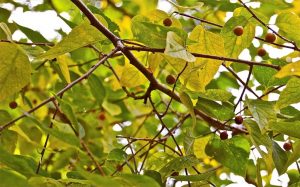
Sugarberries/Hackberries are starting to ripen Aim for September.
There is a tree you should be scouting for now so when the fruit ripens next month you’ll have some already located. As in real estate so in foraging: Location, location, location. Hackberries (also widely know as Sugarberries) like to be near but not in fresh water. You can often find them about 10 feet above the local water table but I’ve seen them as low as three feet. Usually you can find them up the bank from the water. Older Hackberry bark will often be warty, sometimes heavily so. Leaves have uneven shoulders, and on the back side of the leaf notice three prominent veins at the base, unusual for tree leaves. The small-pea sized fruit is green now but will ripen this month or early September into a burnt orange. The entire fruit is edible though the seed is hard. To read more about them go here.
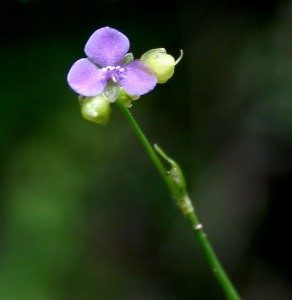
Doveweed is so small foragers over overlook it.
Doveweed, Murdannia, might be the smallest non-floating edible plant in the United States. Barely known, easily overlooked, yet very invasive. It pays to be small. For some young Doveweed is prime for soups, others view it as famine food. I can understand that. It’s closely related to a genus that gives me an upset stomach, the Commelinas (Dayflowers.) I use only Doveweed blossoms in my salad. To anyone used to finding Dayflowers the Doveweed will look familiar but only a few inches tall. It also has a lot of common names around the world including “Micky Mouse.” To read more about the Doveweed, go here.
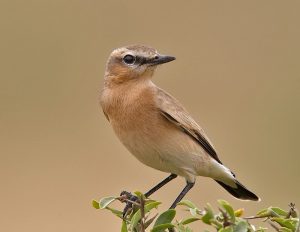
Isabelline Wheateater
To my knowledge I’ve never met anyone named Isabell. So when the word “isabelline” cross my optical path about plants I had to look into it. “Isabell” means “God’s promise” presumably a positive one. It was very popular girl’s name in the 1880s, all but disappear until 2003 whereupon it had a resurgence in popularity until 2007. Now it is on the wane again. But what is isabelline? There are three application of which I have also apparently never heard of. One is what we could call Spanish Gothic Architecture. King and queen Ferdinand and Isabella got Columbus launched then turned to building cathedrals and the like. That style is called Isabelline, properly capitalized. I’m surprised they didn’t called it Ferdinine. The second use is a color: Isabelline. A color? Yes, and the word has been in use for at least 400 years so it is not a paint-store invention like “Baby Fawn.”
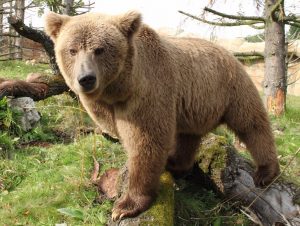
A Himalayan Brown Bear (Ursus arctos isabellinus.)
Isabelline “means a light yellow-gray and used mostly to describe mushrooms, animals and birds. There is the Isabelline Wheateater, see above left, the Isabelline Shrike, and the Isabelline Bear, right. Horses that are a cross between a Golden Palomino and a Champagne Palomino are also called Isabelline. Now, what of the third use? Well… ahem….Isabelline is also a reference to faded underwear. The story comes from when Philip II of Spain laid siege to the berg of Ostend in 1601. His daughter, Isabella, Archduchess of Austria, made a rather presumptuous vow not to change her underwear until the city was taken, thinking dad would be home by supper, lunch by Sunday for sure… Unfortunately for Isabell — and those around her — the siege took three years. Thus the color of dingy underwear is “isabelline.”

Green Deane videos are now available on a USB.
Changing foraging videos: My nine-DVD set of 135 videos has been selling for seven years and are still available. They are the same videos I have on You Tube. Some people like to have a separate copy. A second option is a16-gig USB that has those 135 videos plus 15 more. While the videos can be run from the DVDs the videos on the USB have to be copied to your computer to play. They are MP4 files. The150-video USB is $99 and the 135-video DVD set is now $99. The DVDs will be sold until they run out then will be exclusively replaced by the USB. This is a change I’ve been trying to make for several years. So if you have been wanting the 135-video DVD set order it now as the price is reduced and the supply limited. Or you can order the USB. My headache is getting my WordPress Order page changed to reflect these changes. We’ve been working on it for over three weeks. However, if you want to order now either the USB or the DVD set make a $99 “donation” using the link at the bottom of this page or here. That order form provides me with your address, the amount — $99 — tells me it is not a donation and in the note say if you want the DVD set or the USB.

Green Deane Forum
Want to identify a plant? Perhaps you’re looking for a foraging reference? You might have a UFO, an Unidentified Flowering Object, you want identified. On the Green Deane Forum we — including Green Deane and others from around the world — chat about foraging all year. And it’s not just about warm-weather plants or just North American flora. Many nations share common weeds so there’s a lot to talk. There’s also more than weeds. The reference section has information for foraging around the world. There are also articles on food preservation, and forgotten skills from making bows to fermenting food.
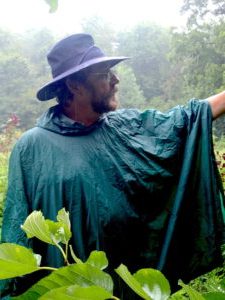
Classes are held rain or shine.
Crossing the state this week with a Saturday class in Port Charlotte and another attempt to have a class at Haulover Canal which is north of the space center.
Saturday, August 15th, Bayshore Live Oak Park, Bayshore Drive. Port Charlotte. 9 a.m. to noon. Meet at the parking lot on Bayshore Road across the street from Ganyard Street.
Sunday, August 16th, Haulover Canal, Merritt Island National Refuge, north of the Kennedy Space Center. Let’s try this again. An ascending bridge thwarted the last class there. 9 a.m. to noon. No drinking water on site, Port-O-Lets for bathrooms. Lots of Mosquitos (and why it is called Mosquito Lagoon.) We meet at the west end of the northwest side of the canal. This class involves more than three miles of walking and can be strenuous.
Saturday, August 22nd, Mead Garden: 1500 S. Denning Dr., Winter Park, FL 32789. 9 a.m. to noon. The entrance is on the west side of Denning. Some GPS maps put it wrongly on the east side off Pennsylvania.
Sunday, August 23rd, Princess Place Preserve, 2500 Princess Place Road, Palm Coast, FL, 32137. 9 a.m. to noon? This class will be donations only. No charge. I have not been to this location but am visiting it to perhaps make it a permanent class location. As to where to meet … how about the parking lot? Discover the park and plants with me.
For more information, to pre-pay, or to sign up of a class go here.
This is weekly newsletter #418, If you want to subscribe to this free newsletter you can find the sign-up form in the menu at the top of the page.
To donate to the Green Deane Newsletter click here.


“They are MP4 files. The150-video USB is $99 and the 135-video DVD set is now $99.”
WHAT! I’ve wanted this set for years, and I finally dropped $135 for the DVDs, and NOW you drop the price? The video quality is extremely poor, and I’m wondering if I was sold a hacked copy.
PLUS, the DVD player doesn’t want to play them, and takes
externity to muck with it to finally get them playing.
Help!
Mr. Brown
Gainesville, FL
The videos on the USB are the same ones on the DVDs but 15 more. Send me a postal address.
unsubscribe please
I live in Japan. which of these species can i readily find here as a beginner?